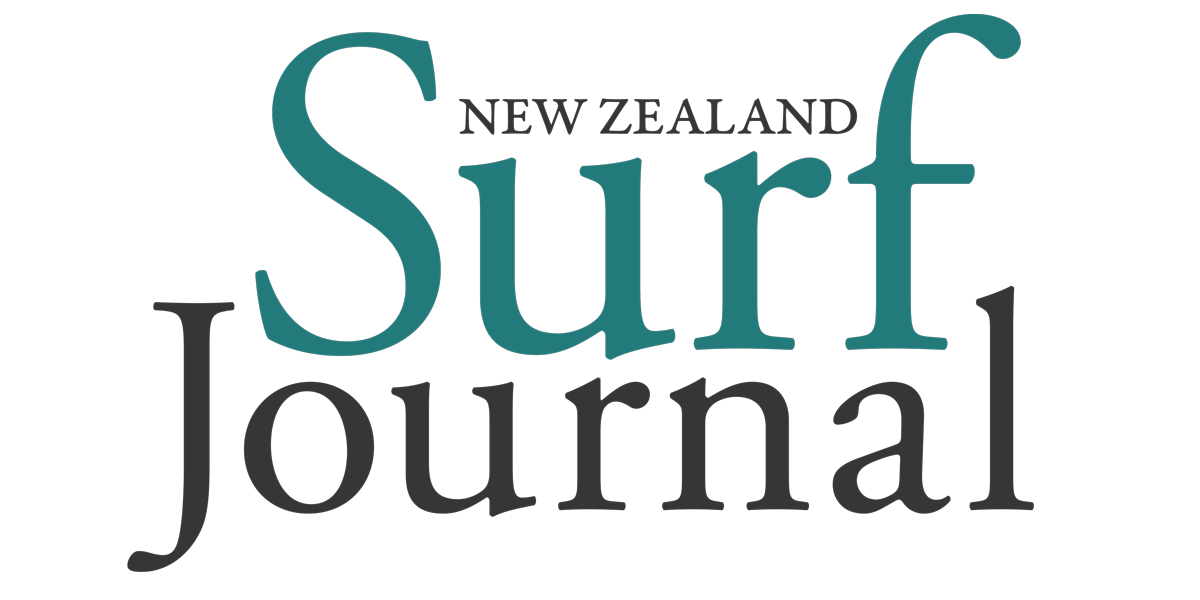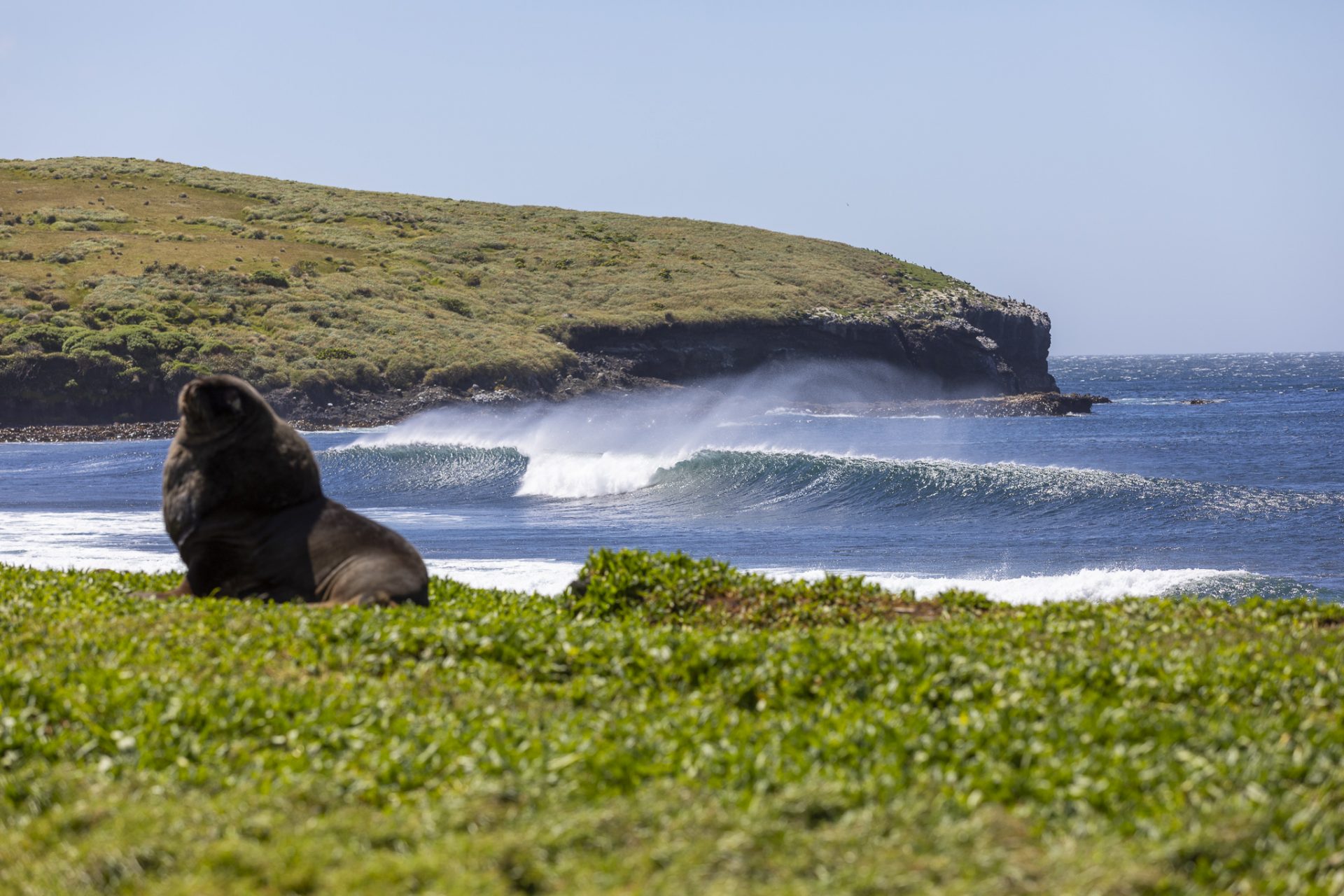Chasing waves on Enderby Island starts with getting to know the locals. They’re furry and blanket the place like lolling beach bums of the south. A little respect (and a lot of patience) will go a long way in this remote part of the Southern Ocean perched on the western edge of the Campbell Plateau. But there is surf to warrant the extra effort required here.
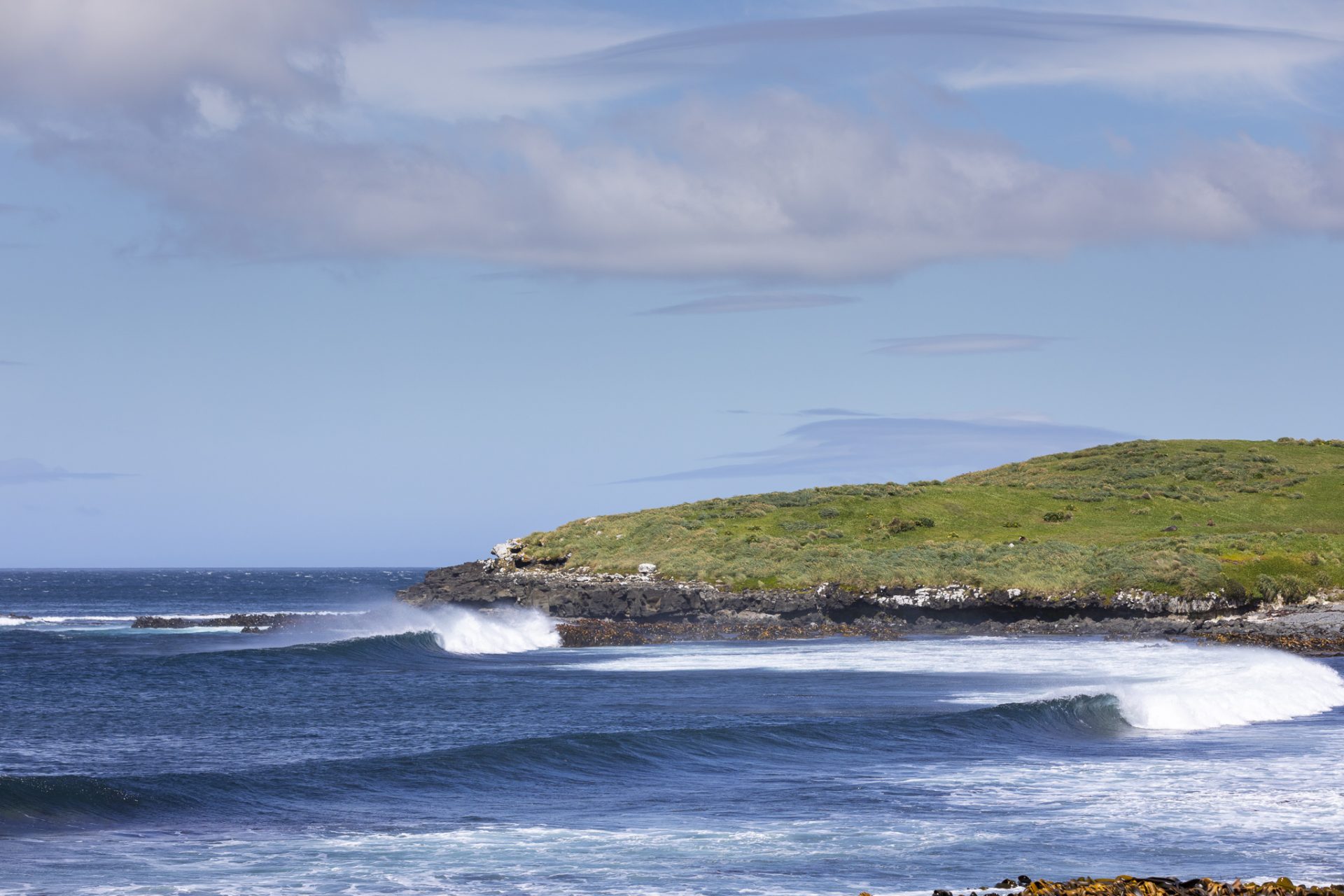
Enderby Island is a 710ha low-lying island in the north eastern tip of the Auckland Islands group approximately 460km south of Bluff. As far as the Auckland Islands go Enderby has the best weather, which can reach 16°C in summer and hovers between 4-10°C throughout winter. It’s a haven for sea lions, yellow-eyed penguins and Port Ross to the south is a haven for southern right whales throughout winter. Otago University researchers estimate around 370 whales visit Port Ross each season. As far as the subantarctic islands go, this place is brimming with wildlife.
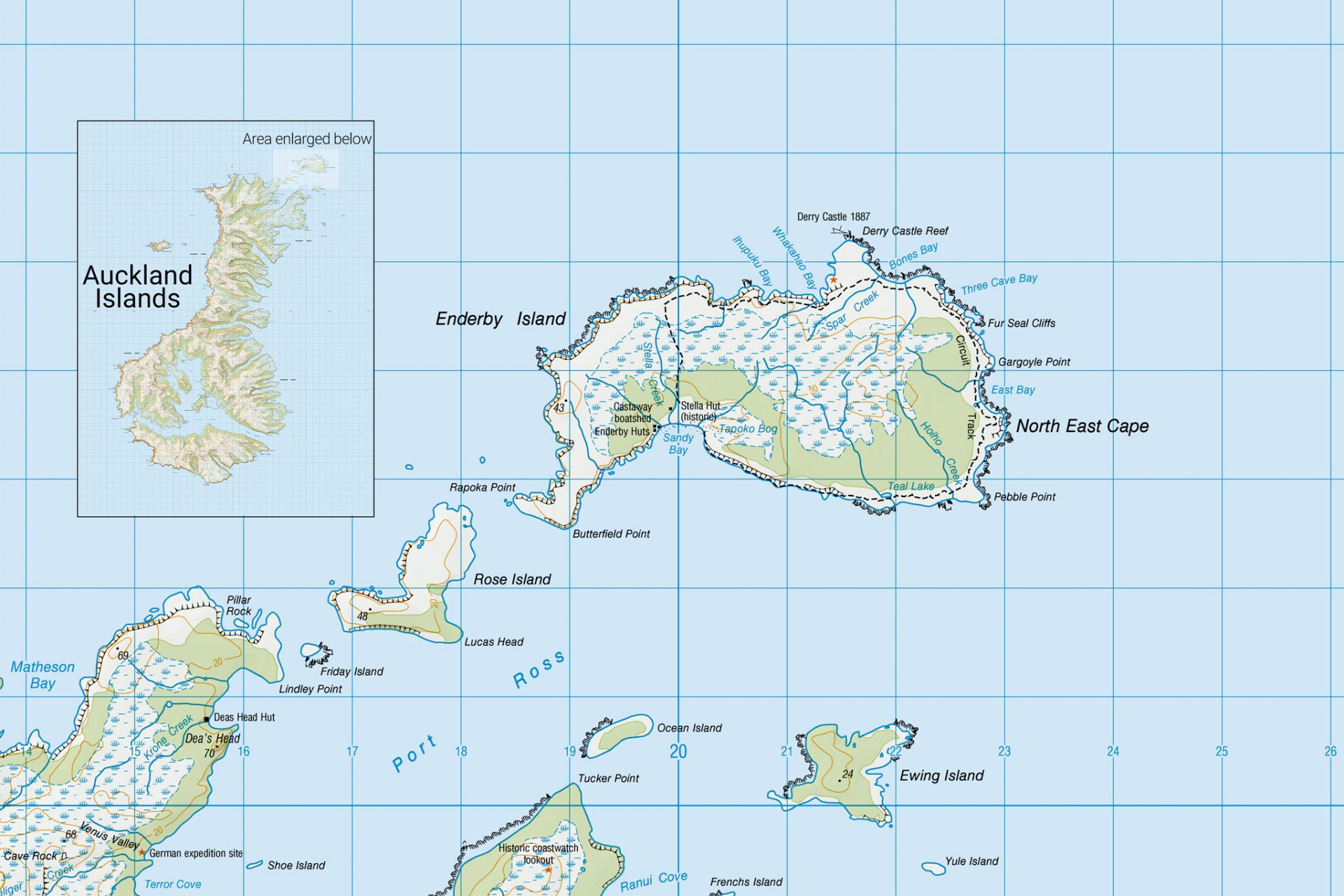
The Spirit of Enderby finds anchor in Sandy Bay and we take the zodiacs toward the beach. I’m accompanied by someone who I imagine would be as close as we might get to the king of Enderby Island: Martin Cawthorn.
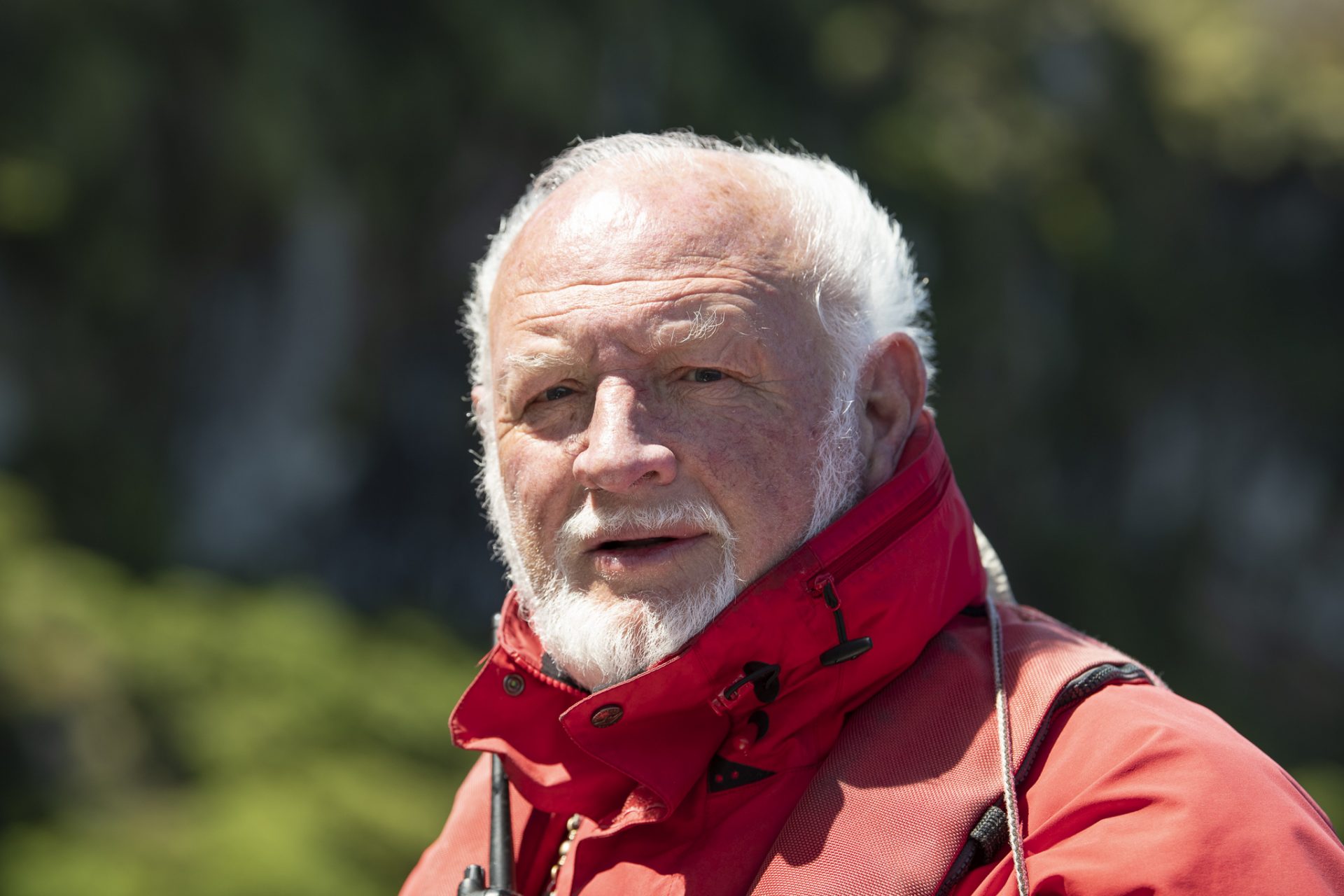
He’s a research scientist who has spent 19 summers on Enderby Island studying its sea lion (Phocarctos hookeri) population. That makes him something of an expert about the biggest marine mammal patrolling the surf breaks.
Our plan for the day is to walk across a boardwalk that intersects the island from the sea lion colony at Sandy Bay, through rata forest and fields of flowering megaherbs to the exposed cliffs of the north west coast and to then loop clockwise around the island’s coast back to Sandy Bay.
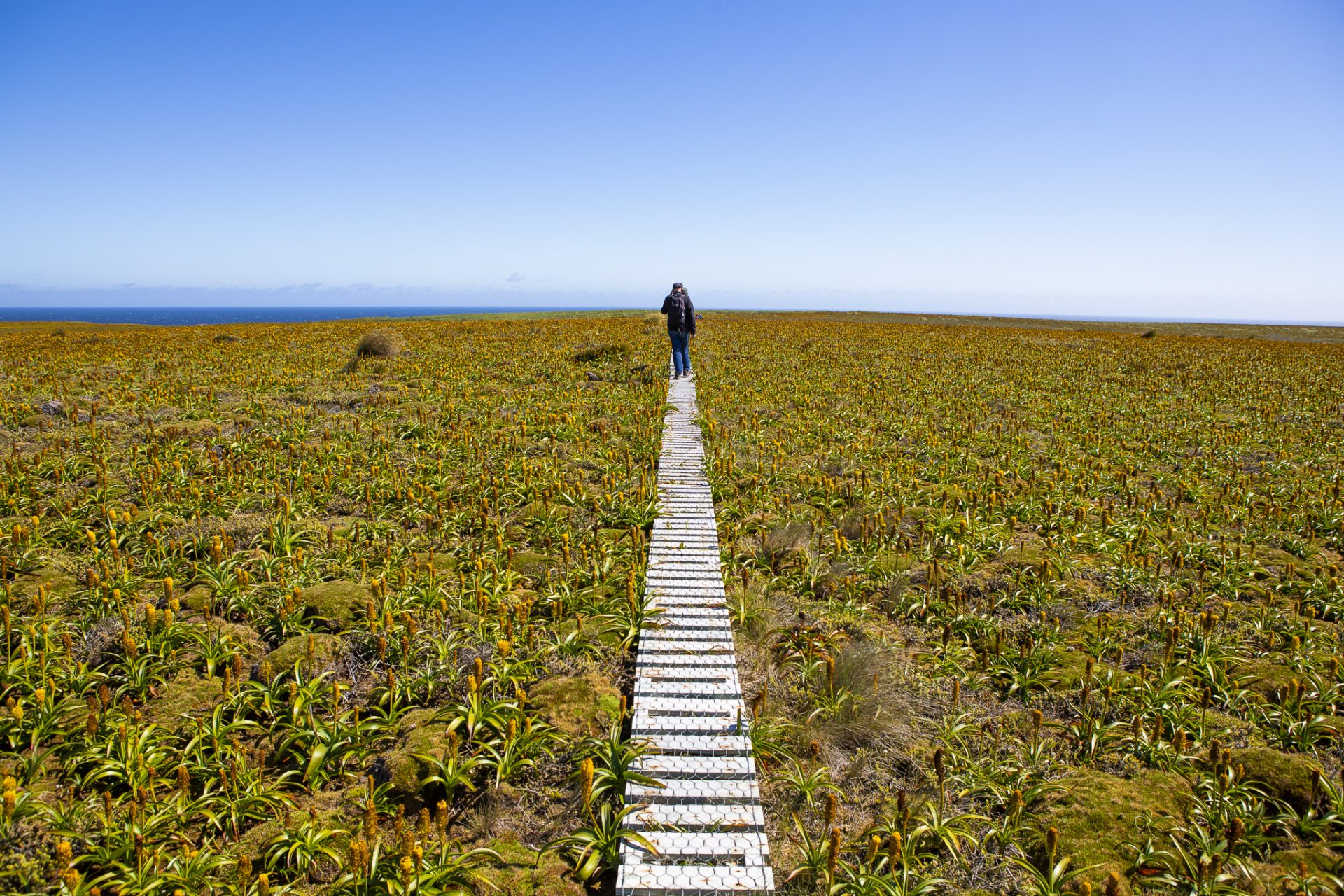
I’m told that will give me the best chance to see the waves that exist along the east coast of the island. I quiz Martin about them and he returns a puzzled glance. I quickly hustle back onto the subject of sea lions and his face flushes with excitement.
“A season was between three months and one month,” he begins. “It depended on what transport was available. We were never guaranteed transport to and from Enderby. We had to beg borrow or steal. In the early days the Lindblad Explorer was working in these parts and I’d give lectures on the way down and then my opo [opposite number] and I would take people for walks around the island.”
Martin would travel with one technician for most seasons and the pair of them became a well-oiled machine. He also managed one winter season alone. In the beginning he camped in the old boatshed
“The programme began formally in the 1979-1980 season with tagging,” Martin explains. “Then the next year we took all the pre-fabricated huts down there. We had two huts built by the Natural History television unit in Dunedin and then my hut. There was one other hut from a previous expedition tucked away in the bush. Nobody used it because it was dank and gloomy.”
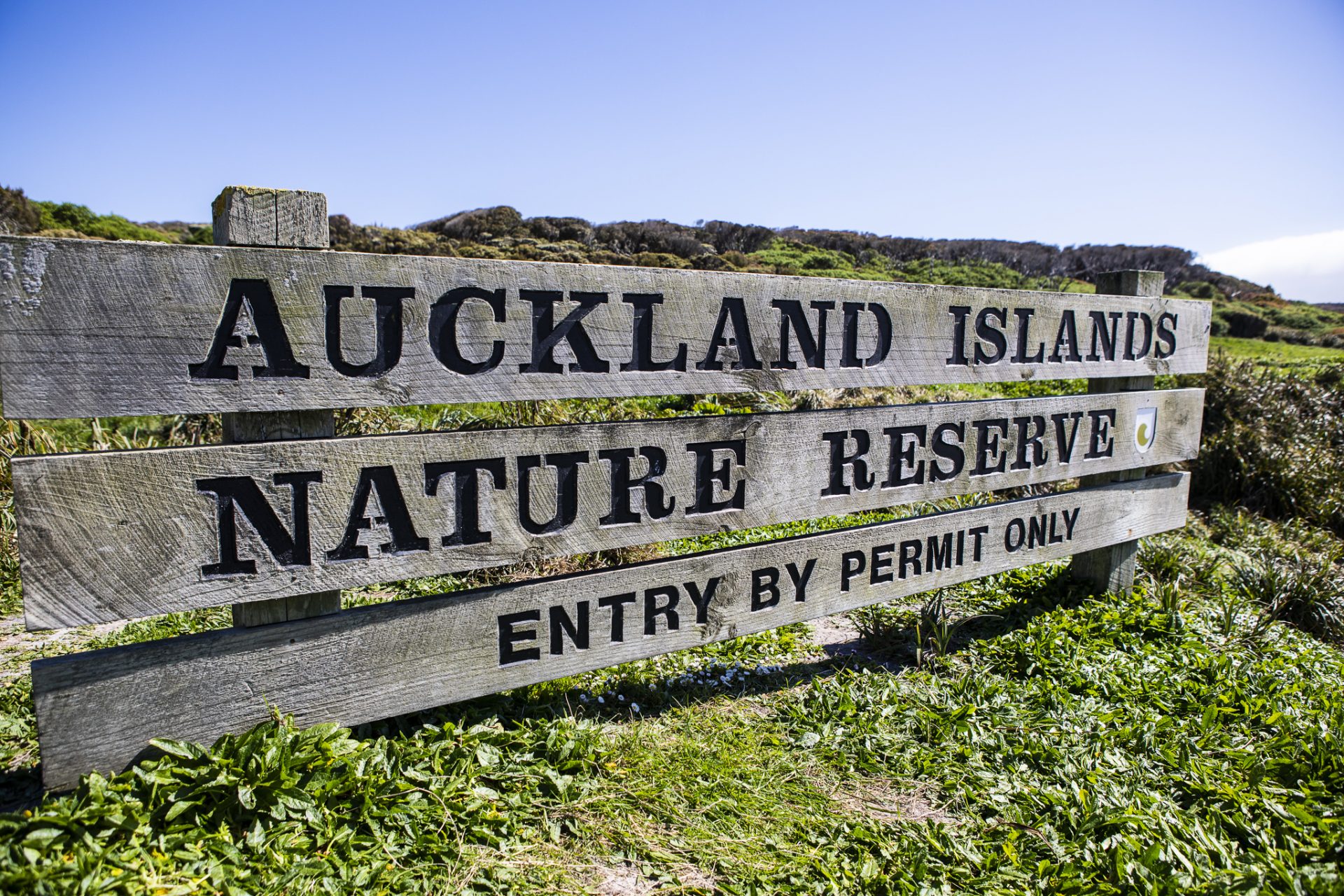
Initially Martin’s work on Enderby Island focused on numbers.
“We desperately needed to know what the population size was,” he adds. “We were working on the second largest rookery on Enderby and the largest rookery had about twice the numbers of Enderby at Dundas Island five nautical miles away.”
Stints on Enderby fell upon Martin during work as part of a fisheries research division team working on the Campbell Plateau with the German fisheries research people studying the fisheries resources of the Campbell Plateau.
“During the course of my work I noticed that an inordinate number of sea lions were being taken as bycatch,” he explains. “Because the Soviet fishing fleet had been down there for some years before we got there – they found the squid resource there – we knew that they had probably take an uncountable number of sea lions. I noticed that the vessel we were on was very big and powerful and towed at a substantially higher speed than the Russian ship, we caught five or six sea lions and that was enough to really get me going.”
Martin went back to head office, drew up a proposal and gave it to his boss.
“I thought a great deal of him – he was a very fair-minded man and a good scientist,” he recalls. “He said, ‘yes, we have a good case let’s get this going.’ He asked me to write up a programme so he could get it vetted and get it going.”
Martin sought a lot of advice from a number of international experts including some of the world’s pre-eminent bio statisticians.
“What we were looking for was a way we could tag as many animals as possible given the size of our budget, which was miniscule, and then at the end of the season work out reliable numbers,” shares Martin. “From the tagging all the other things we did fell into place.”
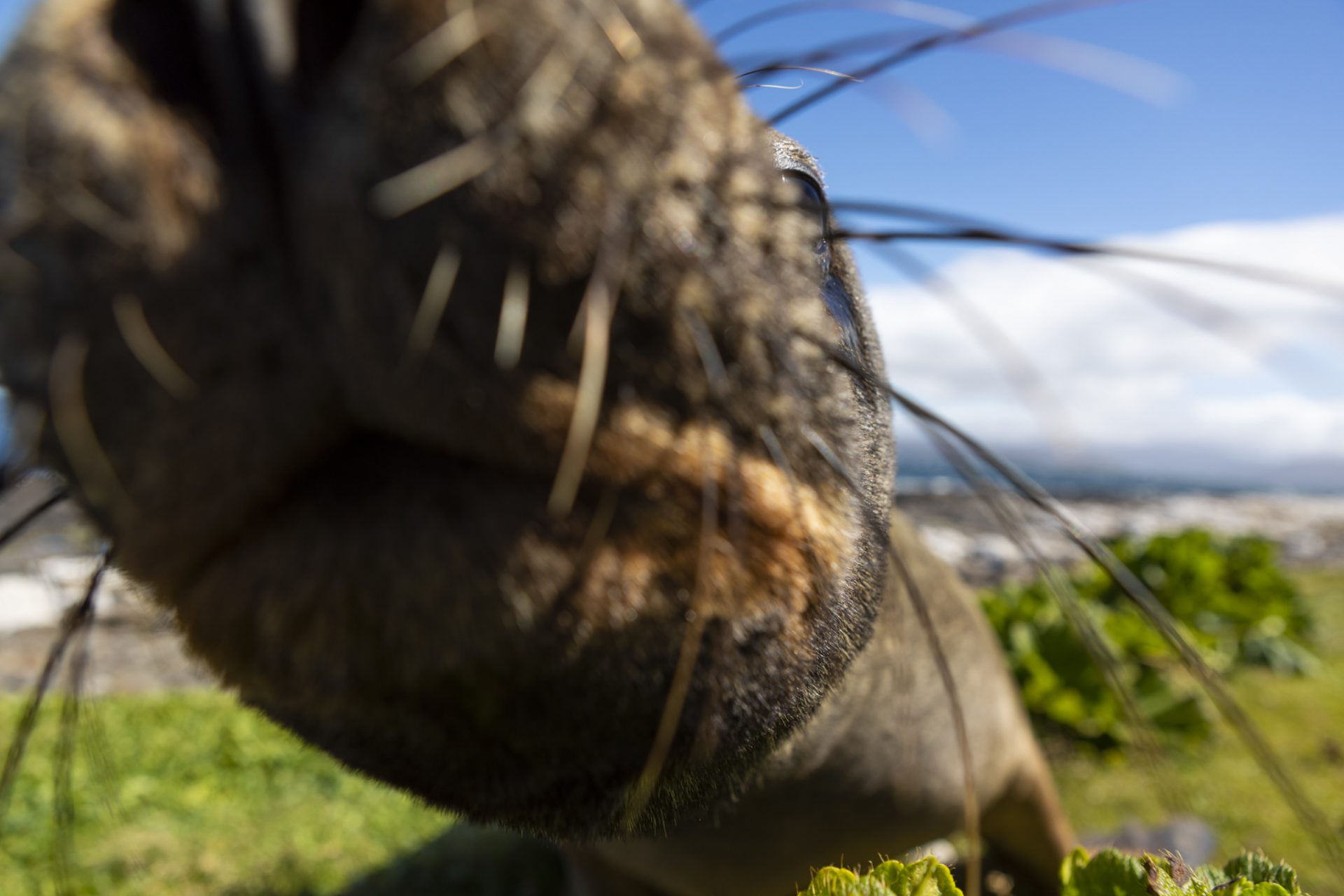
So each summer, Martin would leave his young family and travel south to tag as many sea lion pups as possible. The rest of his year was spent analysing the data, and working on the fisheries research for the Ministry of Agriculture and Fisheries.
“It was very hard to be away from my family for such long periods of time,” he offers with a shake of his head. “When my daughter came down with Heritage Expeditions on a trip she told me that now she understood why I spent the first 14 summers of her life away from home. That was nice, because I felt bad about it, but at least she understood and appreciated why we were doing what we were doing.”
When my daughter came down with Heritage Expeditions on a trip she told me that now she understood why I spent the first 14 summers of her life away from home. That was nice, because I felt bad about it, but at least she understood and appreciated why we were doing what we were doing.
We walk across a field of flowering megaherbs that look like something from another planet. Albatross nest here and there among the plants and we’re careful not to spook a sea lion from its slumber. I ask Martin if he ever had any hairy moments with the sea lions during his field work. He laughs and shakes his head.
“The chap working with me as my assistant was brilliant and the two of us got a long very well,” he explains. “Between us we worked out a system of tagging and measuring. We tagged, weighed, measured and sexed every pup. It worked so well – we were very slick at it. We quickly discovered where the tags have to go so they didn’t damage any blood vessels or anything like that. It worked well.”
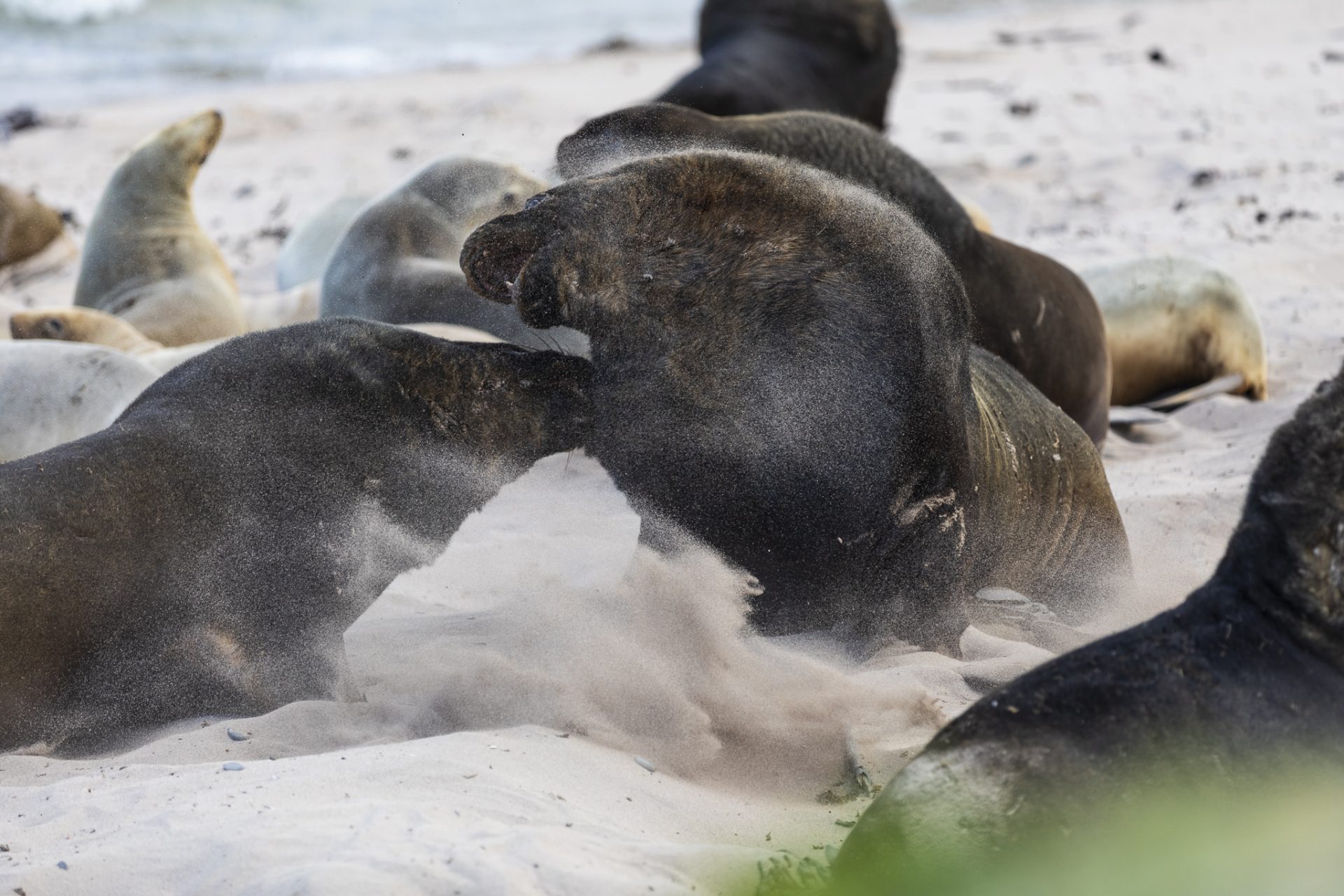
I think for a moment and then ask him how he might go about tagging a fully grown sea lion?
“Carefully,” he laughs. “We do the same thing – if they’re immobilised it’s just the same as a pup. We didn’t have to deal too much with fully grown adults luckily. The biggest problem we faced with our tagging was that when you tag a cohort of pups they disappear in the second year and the third year and possibly come back in their fourth year, so you have no returns. You have to tag every cohort to get the continuity. We had to wait for year three or four until the shiny tags came back and we could then record the tag numbers and see who returned and who didn’t. We did re-weigh some of them as well at that stage. We also reweighed a sample of 100 or 150 of them at the end of each season as well.”
He said he was compelled to come back in the winter because he wanted to see how much the pups grew in six months.
“I discovered it was substantial,” he tells me. “The pups weighed 60-70kg by then. That filled some of the gaps – and that’s what this research is all about – filling the gaps in the data we have. It’s slow and it is tedious at times. You have to be very, very patient. We did tagging, weighing, measuring, blood sampling and genetic sampling.”
Martin and his team also attached time-depth recorders that were cutting edge at the time.
“They weighed 1kg and were shaped like a long bullet and were strapped on to the animals – these days it’s like a matchbox and communicates with a satellite,” he laughs. “But in those days we were lucky and from that data we learnt that the animals had the ability to dive almost continuously to very deep depths – to 500-plus metres. Some animals were deep feeders, some were shallow and some fed in the mid-water. The deep divers were very persistent diving off the slope of the Campbell Plateau.”
“We discovered from the trace from the time-depth recorders that they would do three minutes down, six minutes on the bottom and three minutes up and as regular as clockwork,” Martin smiles. “They would dive through 24 hours and only have a few minutes rest. They are phenomenal animals. They’d pack away as much food as possible and then come in and feed their pup.”
Martin said they weren’t worried about the males.
“When they come into breed they fast for the breeding season, no matter how long it might be for them until they’re displaced,” he offers. “The females are there for the duration, so we primarily worked with the females. They’re also more tractable and easier to work with.”
“We used pharmacology to begin with to immobilise the bigger animals – standard drugs for large animals. It was all pretty new stuff, but it worked. Then I developed a weighing machine that we could use and that allowed us to do the job in 8 minutes instead of 45 minutes or more using the older method.”
We reach the end of the boardwalk and the northern coastline, which is beaten by the sea into a series of cliffs with overhanging cirques and indents pummelled into it. A short period 2m southwest swell runs beneath the chop, disturbed by a light north-westerly airflow. This coast topography holds little hope for waves. We head east along the clifftops.
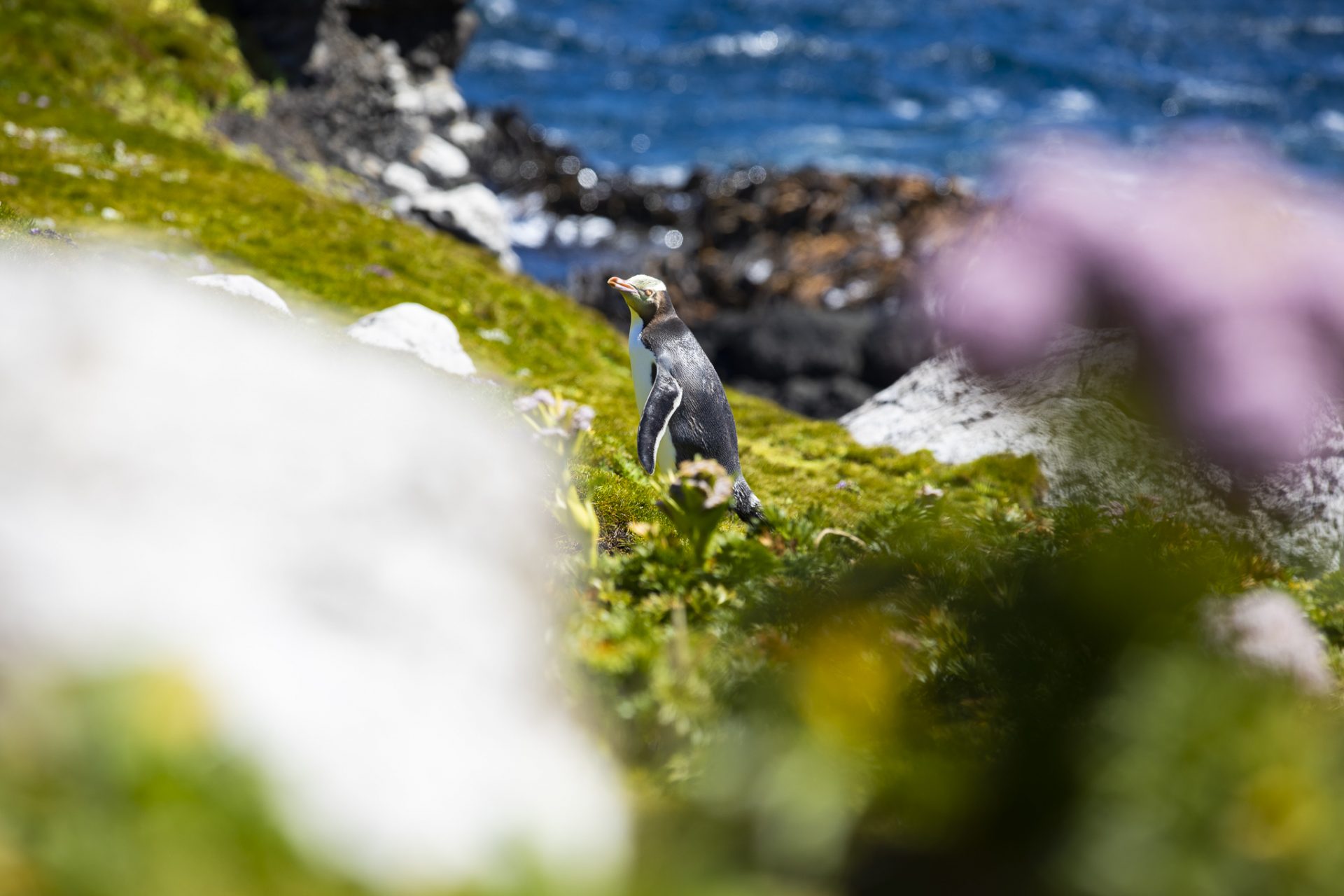
Martin points out four light-mantled sooty albatross nesting in an overhang along the cliff edge below us.
“Later on we discovered the problem with fishing and how many animals were being taken,” he continues. “From that we developed the sea lion escape device and that’s now standard on every boat entering the fishery.”
The net Martin designed and patented features an escape hatch near the top of the net to allow mammals to escape.
“It’s mandatory to have two aboard and use them in every tow. The nets are all certified through a very rigorous certification process and they have to go out on every trawl and they’re checked when they come in.”
It has been a year since Martin has been on Enderby Island, which had its rabbits and cattle removed, along with all other introduced pests by 2001. Since that point it’s bowling green contours have been reclaimed by native herbs and scrub. It’s quite different from what Martin first encountered.
“I am happy with what I have seen, but it is really too early in the season to get an idea of what’s happening with the pup numbers,” he offers. “The people who are working on the species now come in around January 16 – the peak pupping period when virtually 100 percent of the pups will be born. They tag the pups and do all that work and the veterinarians will sample any dead animals for bacterial infections and then they leave.”
Martin said it had been through that sampling through the vets at Massey that they had been able to pin down a major cause of mortality, which is Klebsiella – a bacteria.
“We don’t know where it came from – humans have it, but the environment that the pups live in on the beach with all the animals defecating onto the beach, they might pick it up as they are being born,” he considers. “We just don’t know where they get it, but it is endemic through the population.”
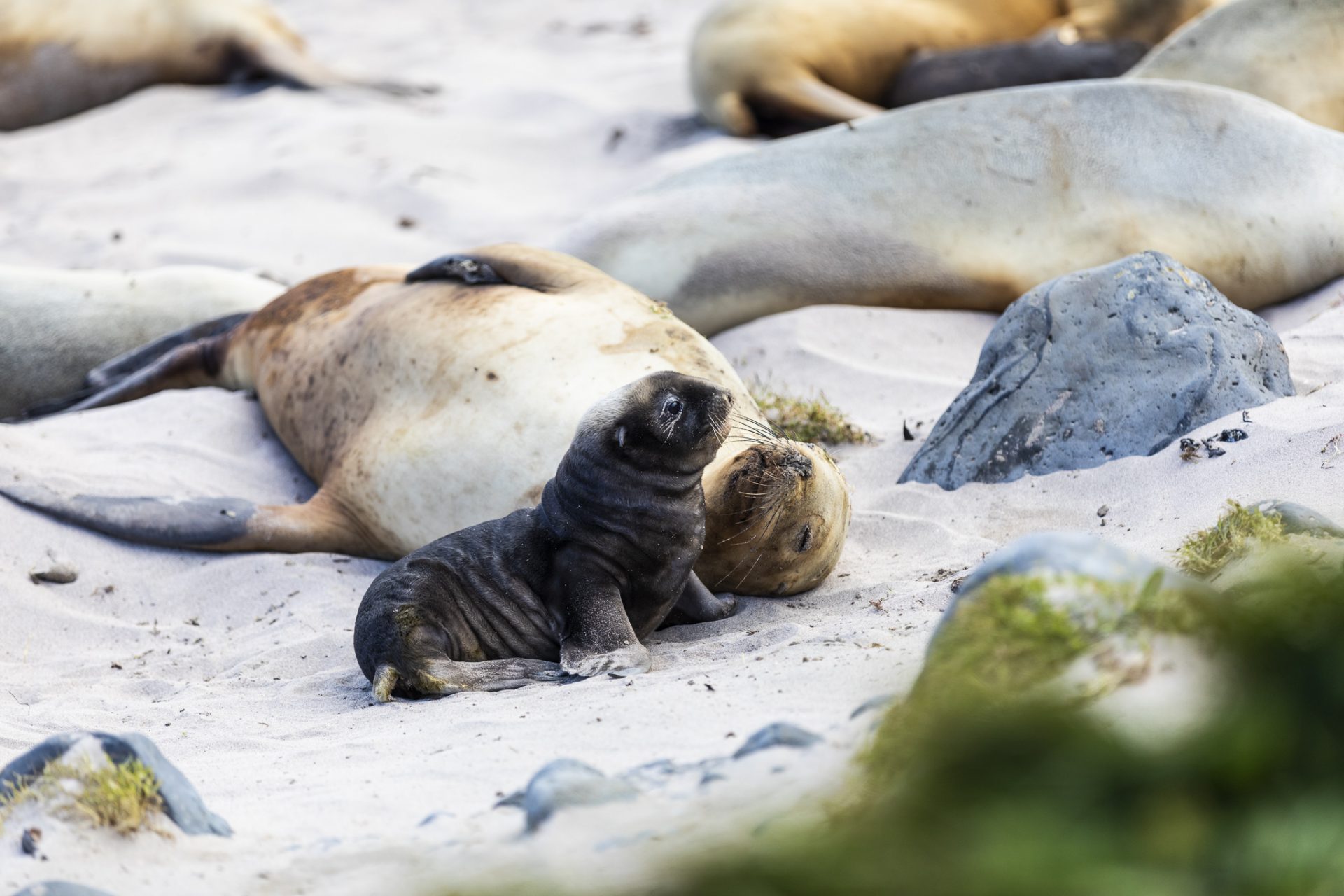
Other sources of mortality for pups – include getting squashed on the beach during fighting among the 400kg-plus males and they are occasionally abandoned by their mothers who can’t find them or are too immature and wander off and lose interest. When the pups are big enough to enter the water they can get taken by sharks. Starvation is another major cause of pup death, usually from mothers losing their pups or the pups being abducted by other animals.
Despite the many risks Martin said he felt good about the prognosis for sea lions in the long term.
“I’m very optimistic,” he smiles. “If you look at the long-term figures there have been cyclic dips and bumps in the graph and they’ve always managed to come out on top and I think they still will.”
“We have a burgeoning population at Campbell Island, although the pup mortality rate there is very high due to accidents more than anything else, but that population is growing.”
He said one unknown was what the level of emigration and immigration was between rookeries, but that certainly happened when he was at Enderby.
“We had animals going to Campbell Island at six months of age – they had never been there before and ‘bing’ straight in. We had all sorts of theories about how they found the island, but we never advanced them. They went in groups of animals of the same age and without adults. It was really very interesting behaviour.”
The pups that went to Campbell Island returned to Enderby to breed.
“They didn’t stay down there which I thought was amazing,” offers Martin. “They’re fascinating animals, I’d love to hear any ideas about how they might be able to find another island. They may use the sun and daylight, but they don’t see a hell of a lot of it down in this part of the world.”
Martin said the Otago colonies were too small to count, but were a promising sign.
“It’s particularly encouraging that they’re breeding on Stewart Island,” he explains. “There they are breeding in the bush, they’re hard to find, it’s remote in there at Port Pegasus. The population is in the vicinity of 30 pups per season. Importantly the pups that are born there will come back and breed there and they have to do that over a number of successive years to establish the colony.”
Colleagues of mine were diving and suddenly found an animal had taken hold of their head just like that. When you think of an animal that can fit your head inside its mouth with room for those big canine teeth, it’s a bit scary.
I ask Martin if he had learnt any tricks to deal with sea lions during his years on Enderby.
“The nice thing was that when we were first working with these animals we felt it was best if we smelled like them and looked like them as much as we could,” he laughs. “So we’d wear the same khaki overalls for the entire season, didn’t wash them, smelt like any number of pups – no specific one – and it was quite astonishing, we could just go onto the beach and pick a pup up, roll it into a little bag, weigh it, put it down again, tip it out and it would still be asleep. The mothers would come over and give us a little nudge to see what we were doing and we’d just continue on quietly and do our work. It was the familiarity with the animals – knowing all the little nuances of position and the way they moved as to whether they were going to become aggressive or wanted to play or anything else – we learnt all those things very quickly – we had to in order to be successful.”
We round a corner past the deep water Whakahao Bay and Derry Castle Reef comes into view. It wasn’t a welcome sight on March 28, 1887 when the iron barque Derry Castle sailed into it and killed all onboard apart from just eight survivors. But for me the familiar shape of a bowling left running on the eastern side of the reef fills me with promise. I watch as three waves reel down and then the ocean goes flat. A couple of sea lions swim around the kelpy peak.
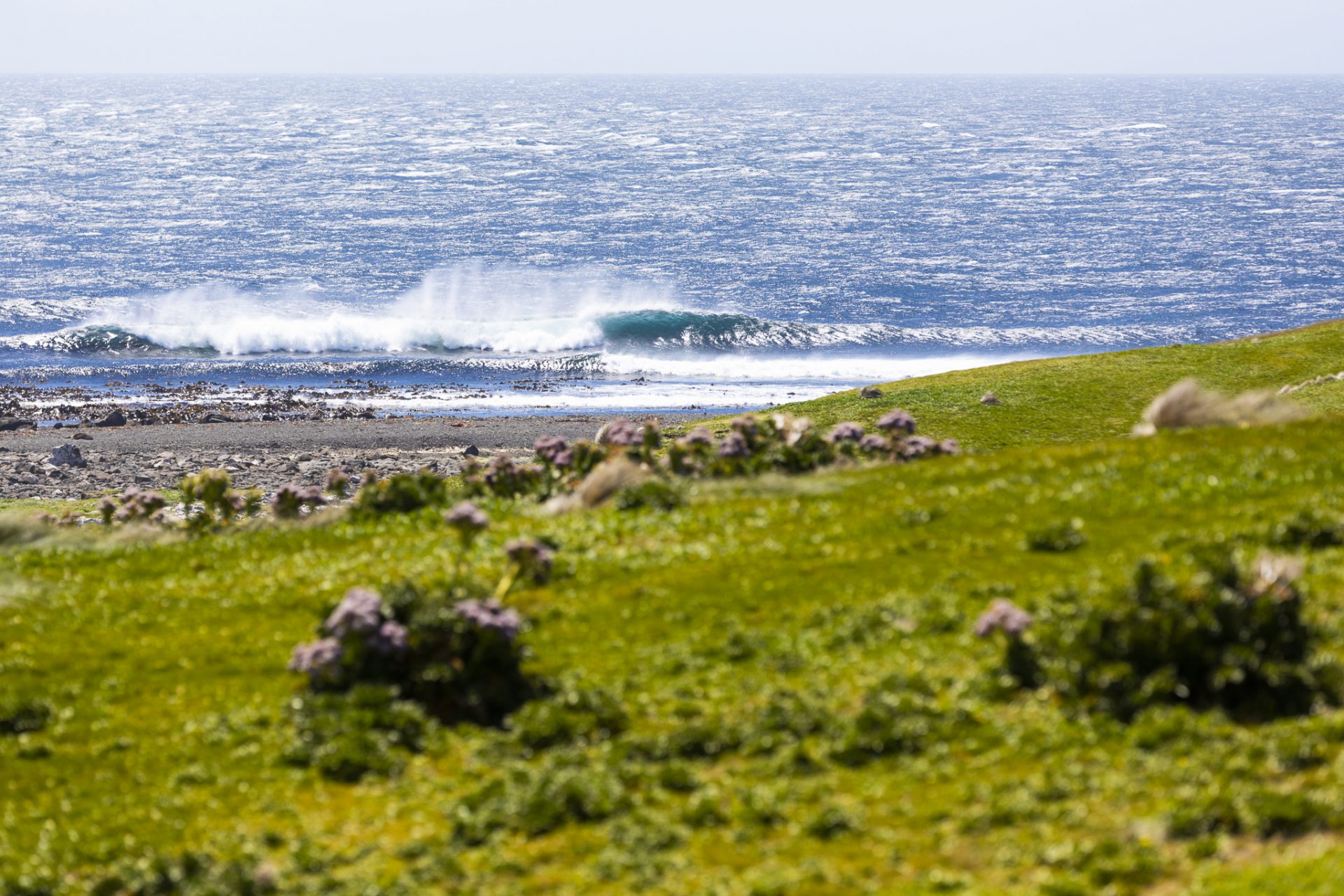
“The key to surfing around sea lions is to take your time and be patient when you’re in the water with them,” offers Martin. “I have to admit that the young bachelor males are more inclined to be pugnacious when they are on their own in the water where they have total command and freedom of movement. They will make threat displays and make open-mouth threats and blow bubbles and a big woof of bubbles into the water alongside you.”
“Colleagues of mine, who were down here at the same time as me doing an inshore fisheries survey, were diving and suddenly found an animal had taken hold of their head just like that,” he shows me clamping his fingers on to his scalp like the jaws of a sea lion.
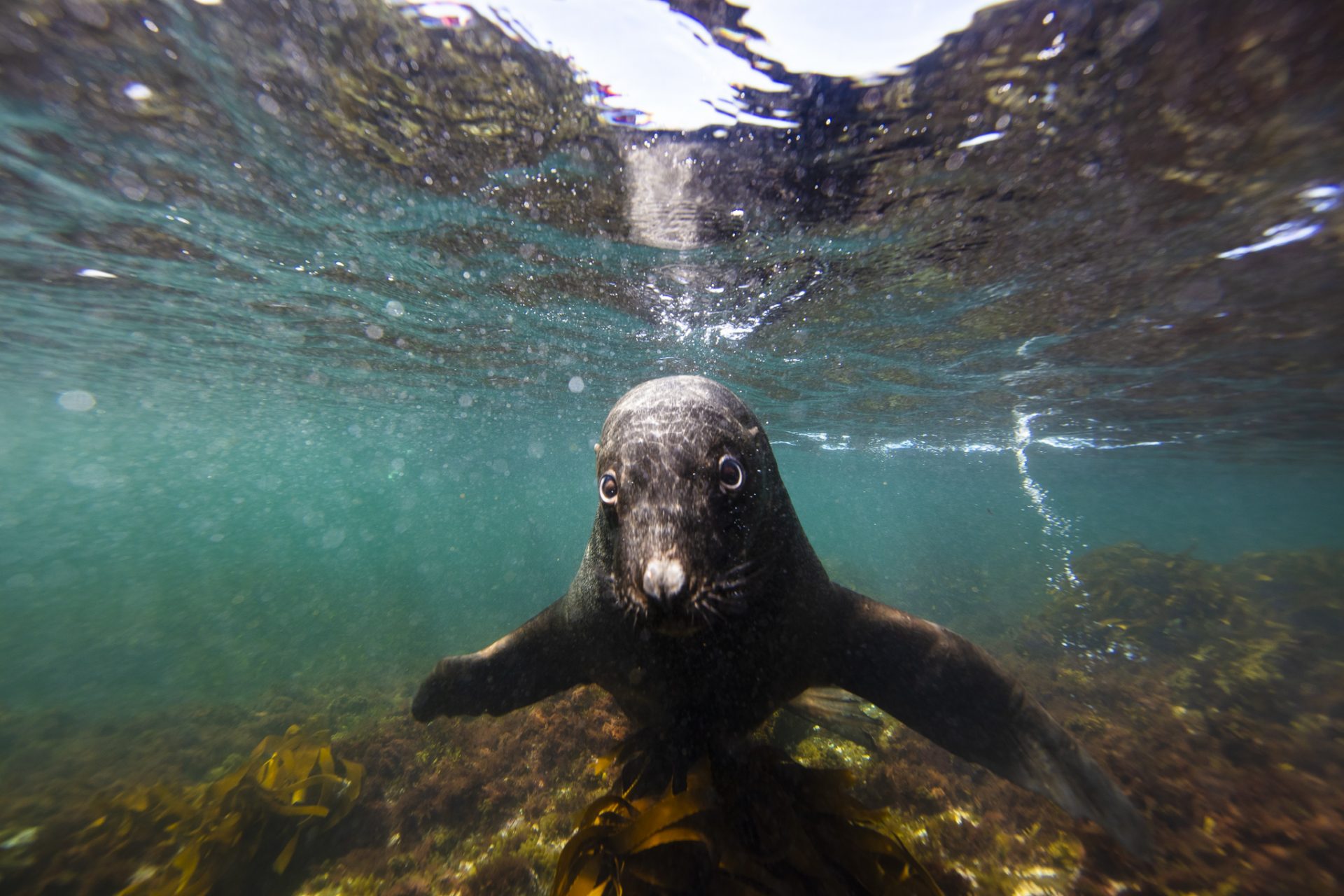
“When you think of an animal that can fit your head inside its mouth with room for those big canine teeth, it’s a bit scary.”
We make our way toward the lefthander as more sets twist around Derry Castle Reef and roll back upon themselves. I ask Martin about the future for the sea lion population.
“One of the things we have to take into account now is climate change,” he offers. “And whether that is having a deleterious effect. The resources the animals feed on may move and so we could potentially get these catastrophic declines like we’ve seen happen with rockhopper penguins and elephant seals both at the same time in the late 1940s. Elephant seals were breeding down at Campbell Island and suddenly there were virtually no breeders at all. We’re quite sure it was due to water movement, water temperature and productivity.”
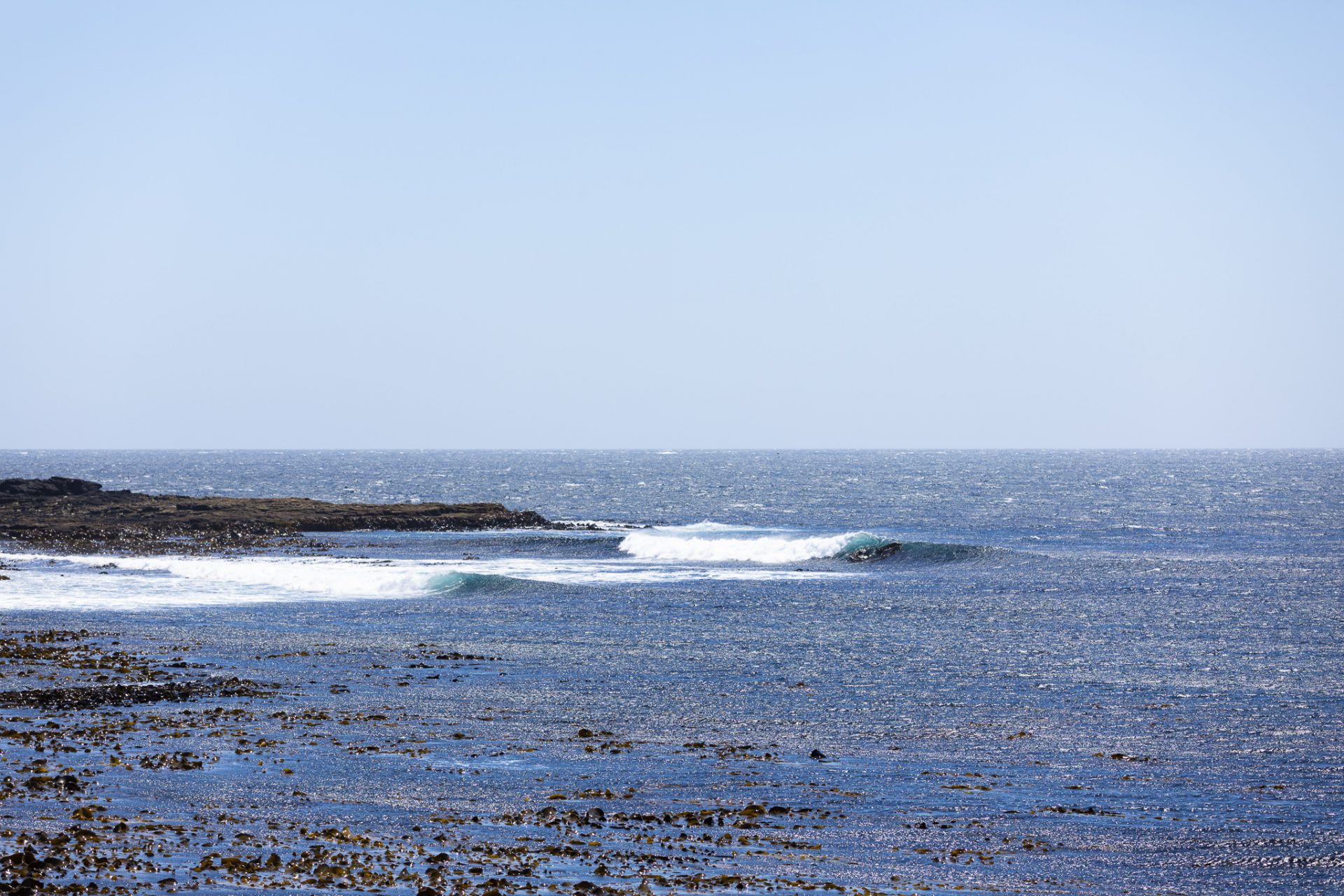
The left peeling into Bones Bay has a distinct peak defined by kelp. The norwester blows straight across it, rippling the take-off. The second section is also defined by kelpy fronds before the wave peels into the bay. There are three waves in every set and it’s about as good as I have seen a wave so far. I’d imagine on a bigger swell it would break further outside but still hold its shape into the bay. It’s about three to four foot on the bigger sets. You wouldn’t want it any smaller.
About 1km further east and a finger of submerged reef breaks in a criss-cross of chaos. I’ve seen the reefs at Timaru in a similar state and it has similar aesthetics to Crosswaves at Newport in Sydney. On a big swell there it would be an interesting place to check.
The coastline then bluffs out with little promise for surf right across to Gargoyle Point.
Martin tells me that his last season here was the 1993-1994 season.
“It was that year we had an accident down there – the first ever accident on Enderby Island,” he recalls. “It was caused by faulty gas bottles. Up until then we’d never ever used gas, but those coming in decided it was the best thing.”
The faulty gas bottle exploded, luckily while everyone was out, and quickly reduced the hut, belongings and research equipment to ashes.
Martin went solo after that, left government and took contract work thereafter. I ask him if he misses his time on Enderby and his sea lions.
“No, not anymore,” he answers. “I do keep an eye on it out of interest. The guy at Niwa, Jim Roberts, who is doing the work now is genius, first-class. Anything I can find that might help him I hand over to him. Like accounts that I made while we are here on the beach – I hand them all that data because it allows them to get a feel for the duration of the breeding season.”
Martin recorded 13 pups during our visit, including several that were born in front of us.
We scramble through head high tussock and scrub toward Gargoyle Point and are rewarded with a bay filled with waves and the norwester feathering them at just the right angle.
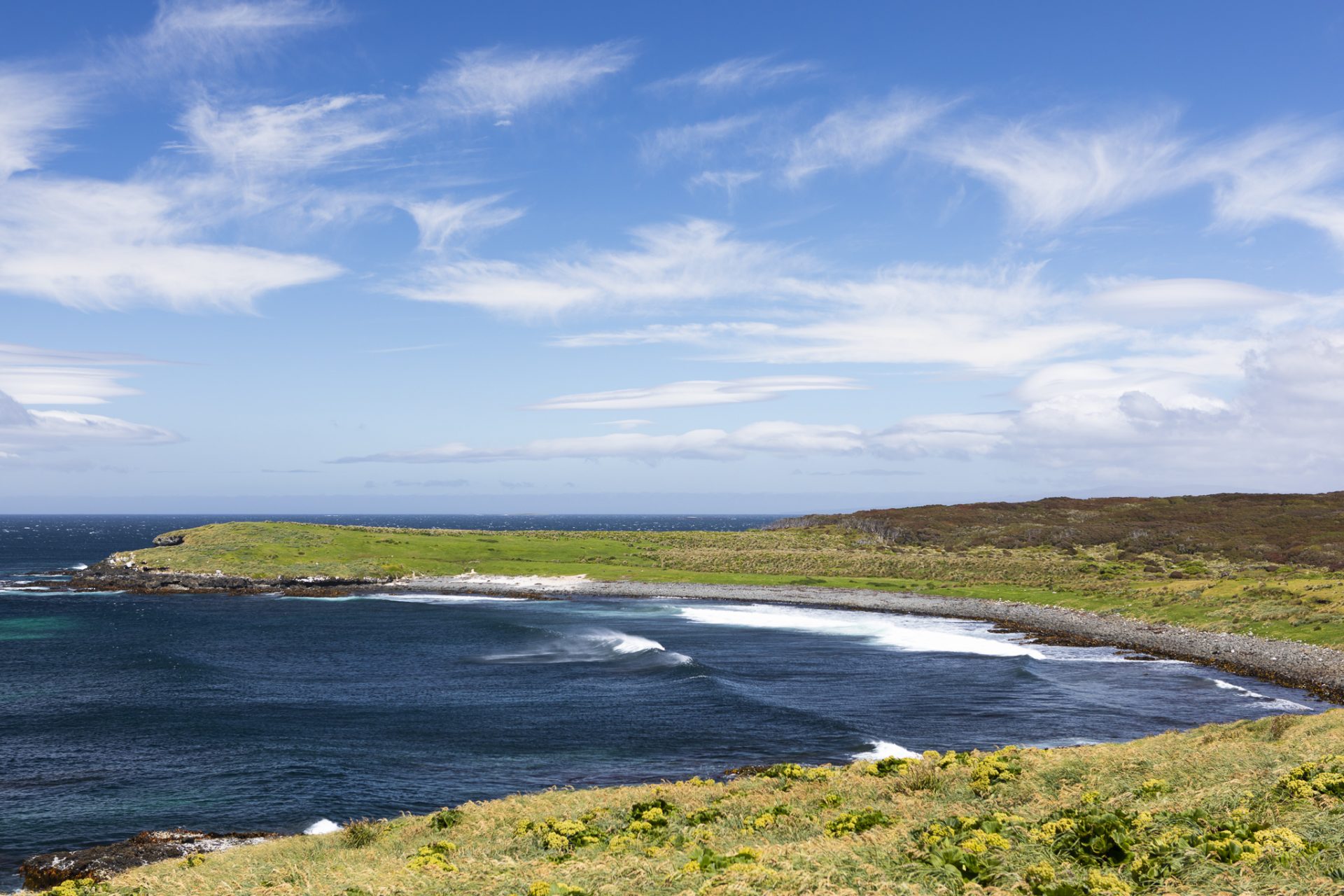
East Bay is the eastern most bay of Enderby Island and has a lefthand point in the north end, a peak in the middle and a righthand point in its south end. At around 3 foot the lefthander breaks on a shallow rock slab and then winds out into the bouldery bay, but on a bigger swell it links up a lot better – only the biggest sets would make it right through. The peak has a short right, but is more of a left that peels nicely into an eventual closeout where it meets up with the righthand point. It reminds me of Tapotupotu Bay near Cape Reinga in that it relies on swell wrapping around and into the bay, albeit with a decent point at each end. The left is quite hollow at times.
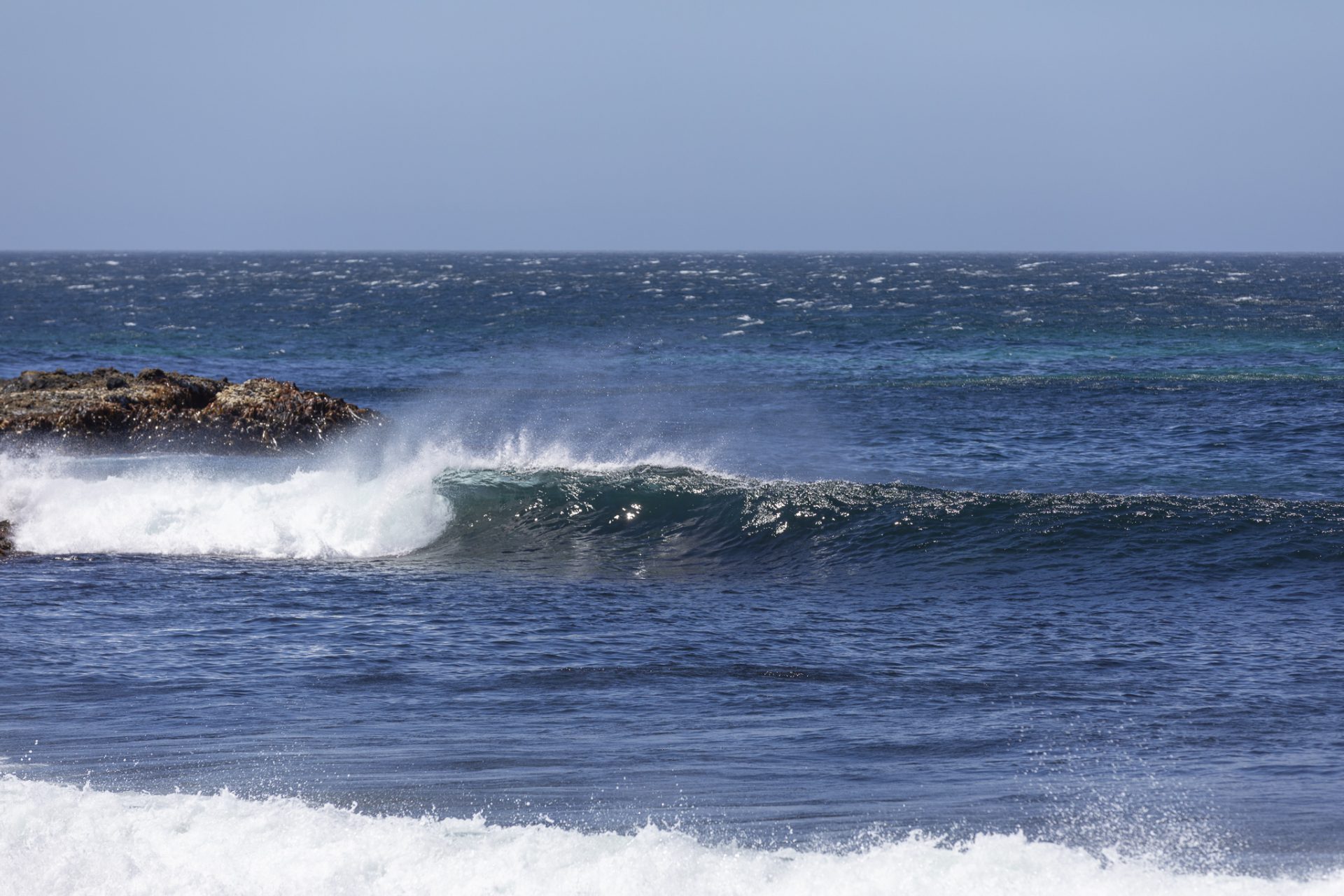
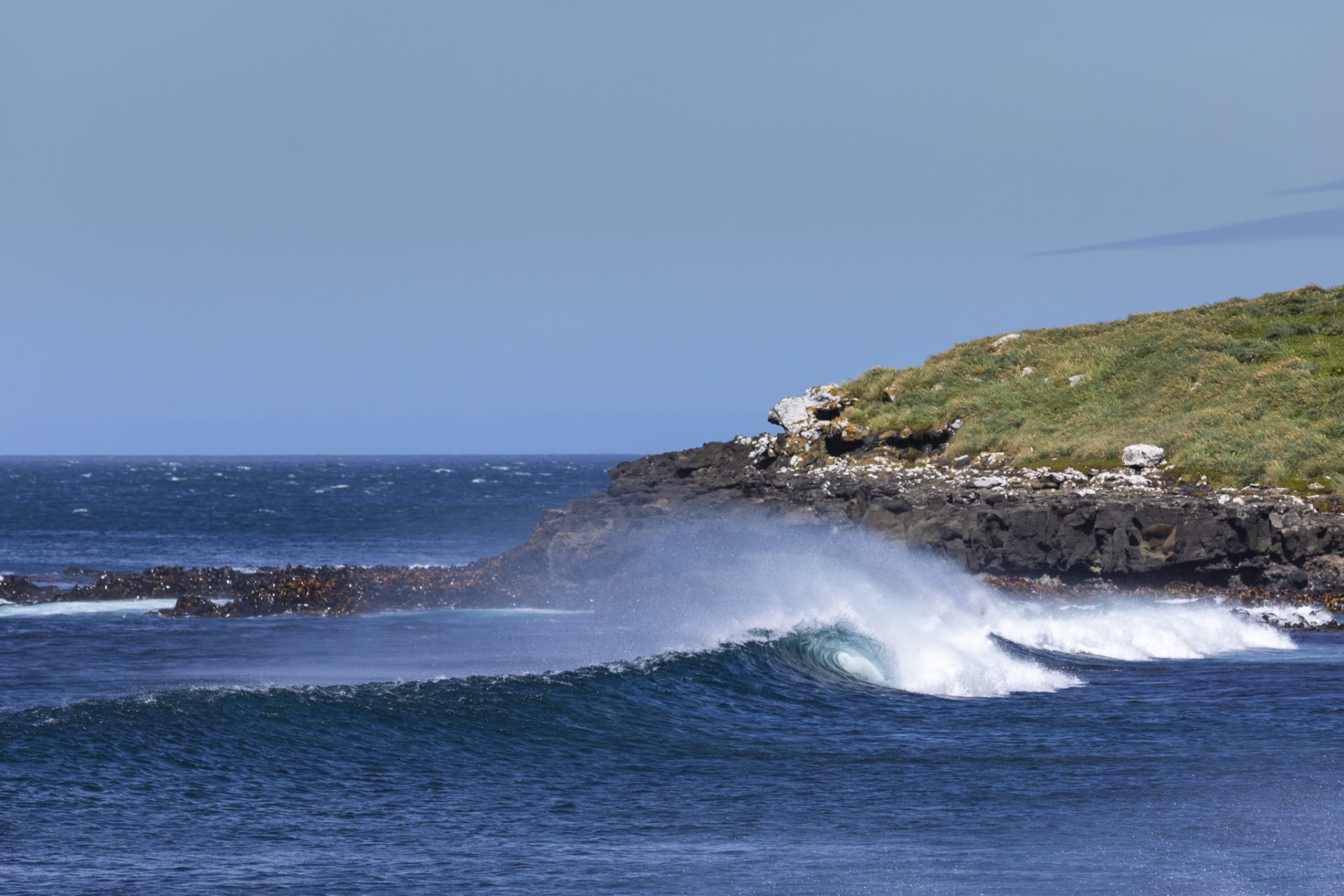
The righthand point is definitely the star of this trilogy, with consistent lengthy rides of 100m or more and the potential on bigger days to link from an outer rockslab right through. There are some shallow sections, but overall the pace of this wave looks like a mirror image of the Valley at Raglan.
East Bay is also popular among sea lions and we watch one surf right in towards us. Meanwhile a large male, with three females in tow, fends off rivals on the grassy embankment next to us.
We reluctantly leave East Bay and head towards Sandy Bay – still a few hours trek away. I feel strangely satisfied to have found some waves but tinged with that familiar pang of anxiety at the possibility of being able to surf them one day. Logistically, that was not going to happen on this trip.
The next feature on the coastline is Pebble Point, the last exposed coastline on Enderby before Port Ross. I know waves have been spotted here from some of my surfing scientist friends who have spent time down here during winter studying the southern right whales.
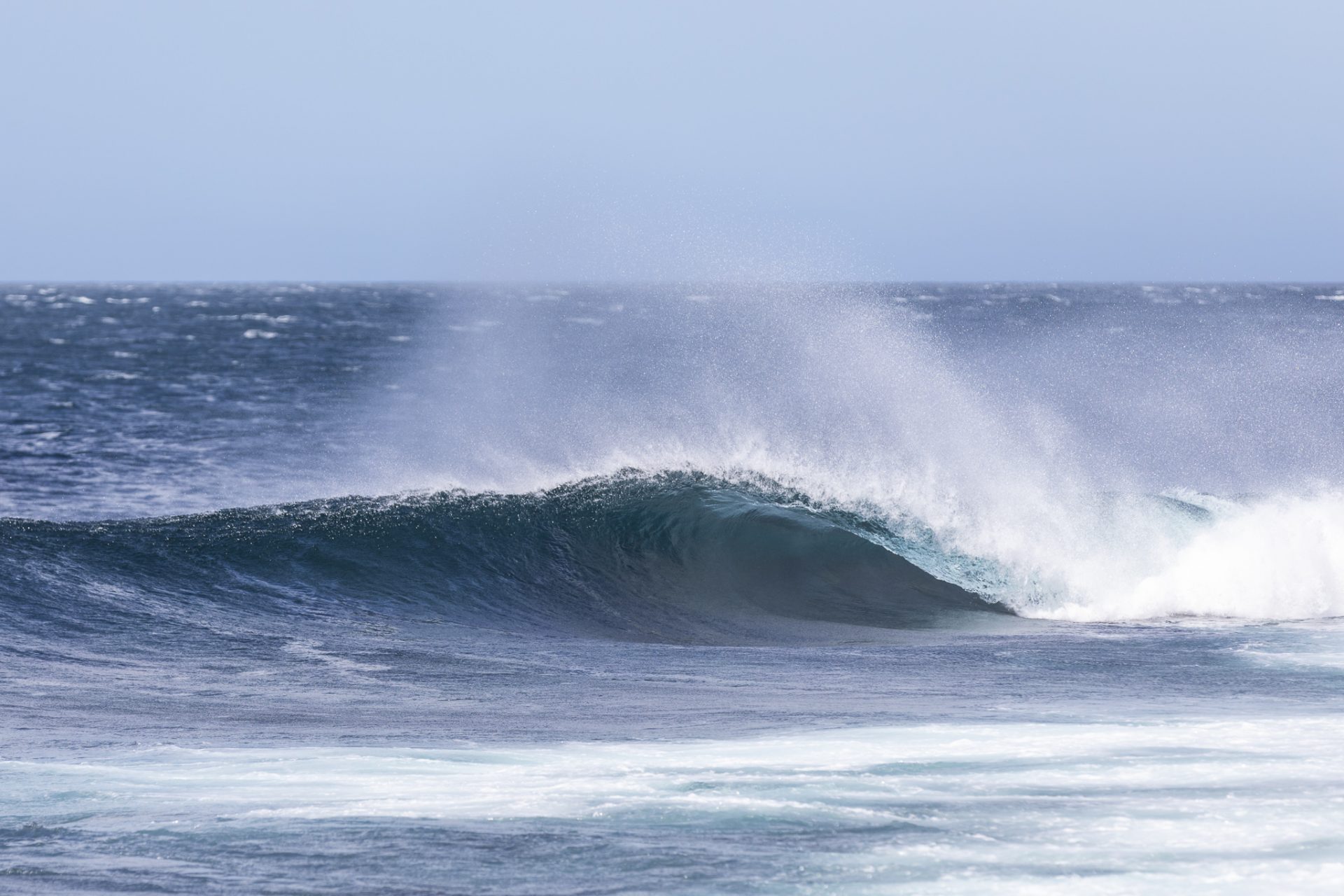
True to reports, a righthander peels along a finger of reef. In this swell it’s on the small side, but definitely rideable on the bigger sets and promises a couple of fast, hollow sections. A small rock slab bowls up glassy on the northern side of the bay – too small to surf, but with shades of The Spit at Mahia. I wonder if it might produce a more meaningful wave with a big swell running. Again the line-up is dominated by sea life with sea lions making the most of the sunny afternoon. One particular animal darts in and out riding waves repetitively from the peak through to the kelp. There’s no question they’d love to have a human to entertain them out there. That won’t be me today as I still have a few kilometres of coastline to walk back to Sandy Bay.
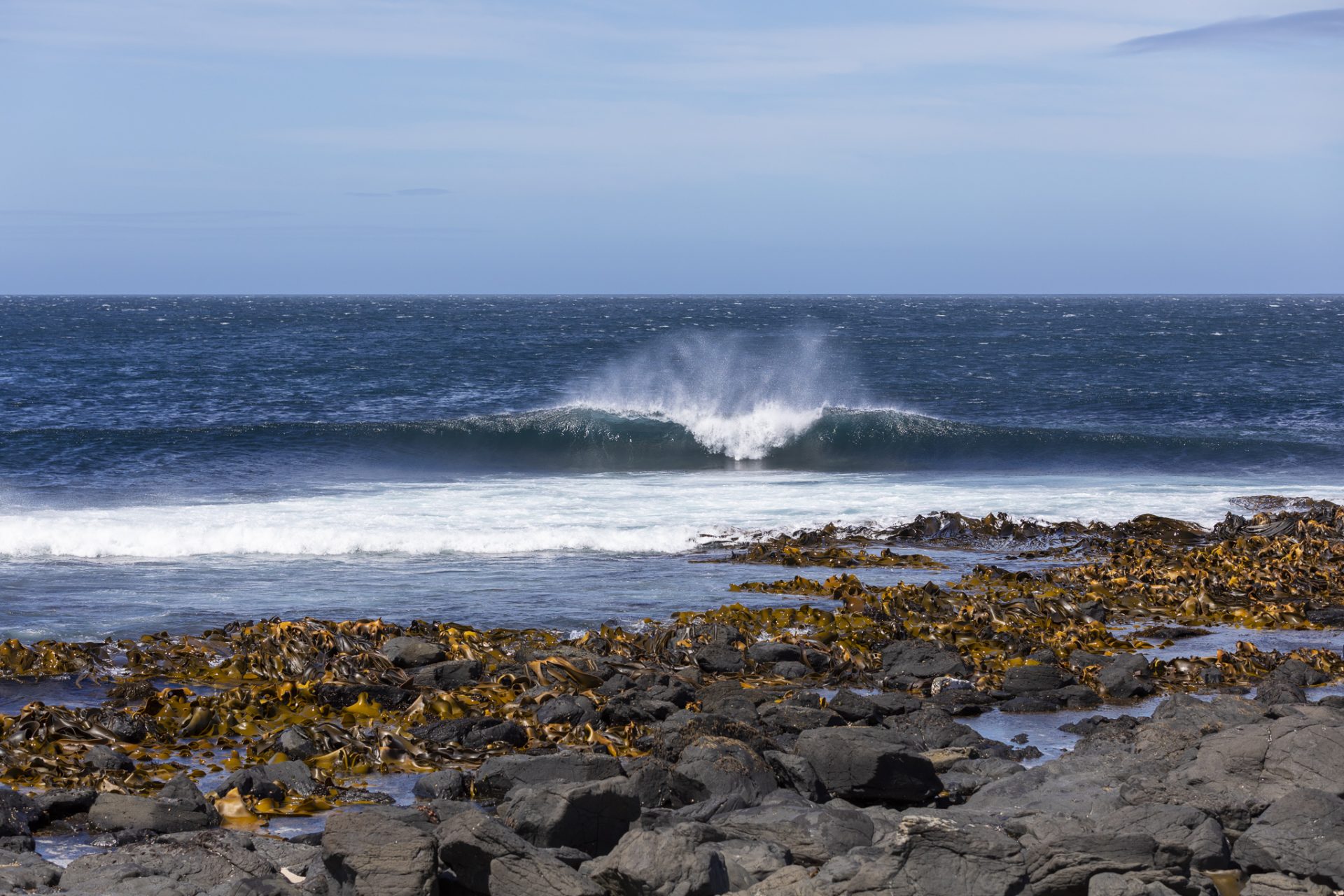
Surfing on Enderby Island is a bit of a logistical challenge. It requires a permit from Doc and you’d need a decent vessel to get here across the wild gauntlet of Southern Ocean. Then you’d need to be prepared to share waves with very large sea lions. In the back of your mind will be sharks and so they should be. They’re commonplace here, large and not well socialised with humans. I’d suggest going as far as wearing a shark suit or repellent device similar to the ones used by divers in South Australia. The water itself is around 12°C and I was warm in my 4:3 steamer with hood vest, booties and gloves.
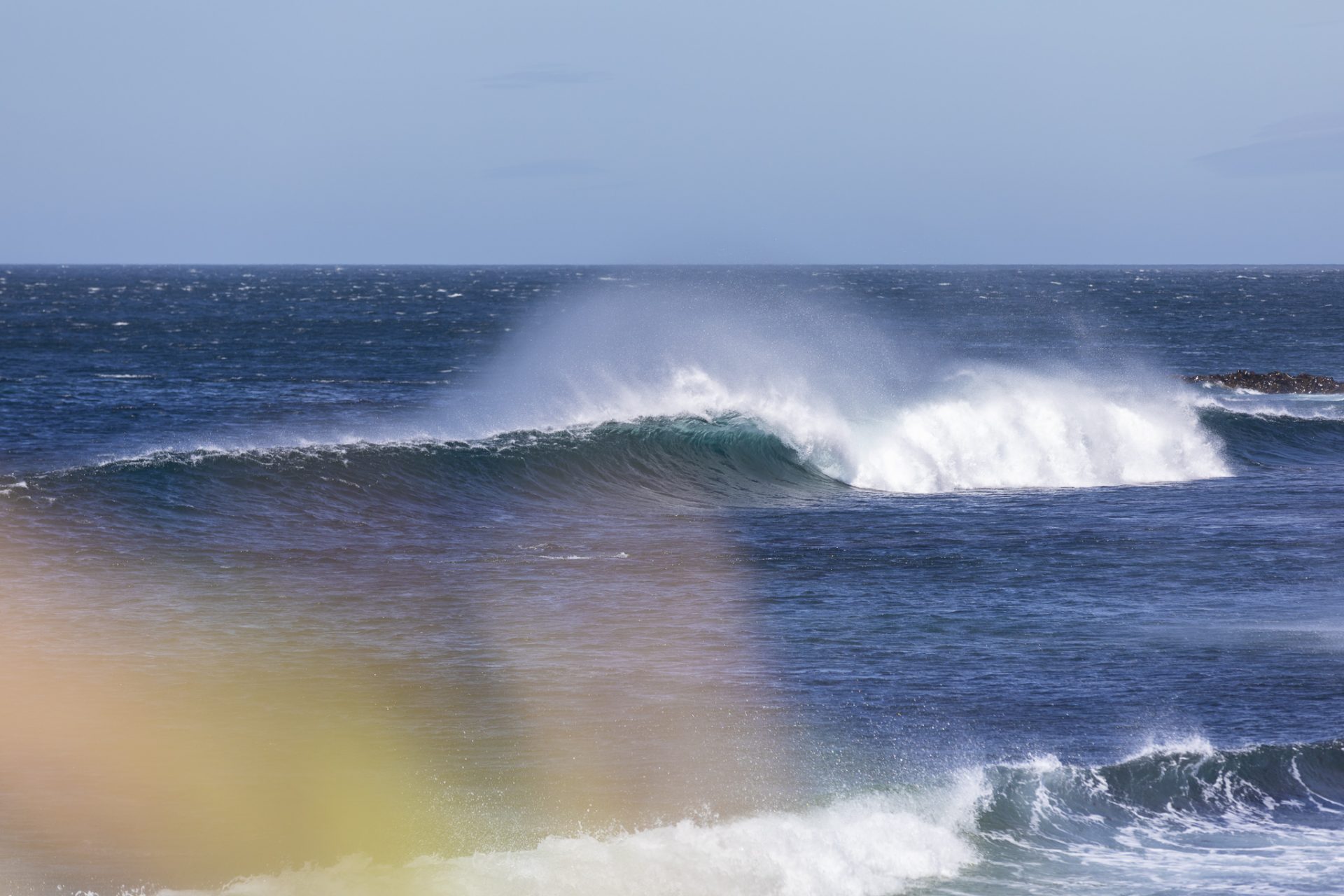
In saying that, we did encounter a series of rare, beautiful days on the Auckland Islands …
We’re keen to revisit these waves. If you are interested then get in touch as we’d love to put a crew together to go and surf these and explore a little further. Bring your brave.
